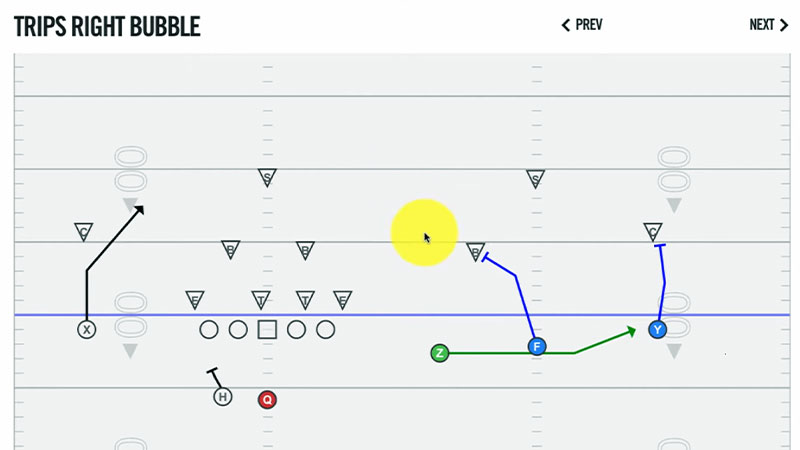The bubble screen is a quick, strategic football play designed to exploit defensive weaknesses and create opportunities for significant yardage.
It involves a wide receiver catching a fast pass behind the line of scrimmage and using blockers to navigate through the defense.
The effectiveness of this play hinges on the timing and coordination between the quarterback, wide receivers, and the offensive line. The quarterback must deliver an accurate pass, while other receivers block to create running lanes.
Mastering this play involves understanding defensive tendencies and aligning the offensive scheme to capitalize on mismatches, making it a powerful tool in any team’s playbook.
In modern football, teams often utilize the bubble screen to counter aggressive pass rushes, as it quickly gets the ball into the hands of a playmaker.
Coaches emphasize precision and practice to ensure it can be executed flawlessly, turning a simple pass into a game-changing play.
Bubble Screen Explained: A Deep Dive into Football Tactics
The bubble screen is a popular play in American football, especially in spread offenses. It’s designed to quickly get the ball to a wide receiver (WR) in open space, allowing them to use their speed and agility to gain yards.
Here’s a detailed breakdown of the bubble screen:
What Is a Bubble Screen?
A bubble screen in football is a passing play designed to exploit defensive alignments. The quarterback quickly throws the ball to a wide receiver positioned behind the line of scrimmage.
Usually, offensive linemen or other blockers move ahead to create pathways for the receiver. Timing and precision are crucial, as the play aims to capitalize on defensive hesitations.
This play is especially effective against aggressive defenses that overcommit to pass rushes. Proper execution can lead to significant yardage with minimal risk if the blockers perform their roles well.
Key Objectives of Using a Bubble Screen
The bubble screen’s primary objective is to gain yardage by utilizing blockers and the receiver’s speed. This play tests the defense’s ability to react quickly while effectively engaging blockers.
If executed well, it can turn a short pass into a substantial gain. Also, it stretches the defense horizontally, which opens up opportunities for other offensive plays.
Implementing the bubble screen in your playbook can enhance your team’s offensive strategy by adding an element of unpredictability. It’s especially useful against defenses that tend to over-pursue or have weaknesses on the perimeter.
Executing the Bubble Screen Play
Executing the bubble screen play requires precise coordination and timing among offensive players. Leverage these key elements to maximize the effectiveness of this play.
Offensive Strategies
Quick execution is crucial in football bubble screens. Quarterbacks must release the ball swiftly to minimize defensive response time, while receivers should move decisively downfield once they catch the pass.
Offensive linemen and additional blockers need to create clear running lanes for the receiver. Varied formations can disguise the play and prevent the defense from anticipating it.
Effective communication among players is essential for adjusting blocking schemes based on defensive alignment. Practicing timing and precision regularly can enhance execution, helping teams disrupt defenses and achieve significant yardage gains.
Positioning and Player Roles
Position the wide receiver slightly behind the line of scrimmage to catch the pass with forward momentum. The quarterback needs to identify the defense’s formation and potential blitzes quickly.
Assign blocking duties to offensive linemen and nearby wide receivers to disrupt pursuit and open lanes. Choose receivers with speed and agility to optimize yardage after the catch.
Use pre-snap motion to confuse the defense and create mismatches, and practice timing and precision to ensure smoother plays and break through defensive lines.
Defending Against the Bubble Screen
Defending against the bubble screen involves anticipating the play and neutralizing its quick execution. Focusing on defensive alignment and player roles can dismantle the offense’s strategy.
Common Defensive Schemes
Common defensive schemes against the bubble screen include press coverage, zone coverage, and man-to-man coverage, each designed to disrupt timing and limit yardage gains.
- Press Coverage: Pressing the receivers at the line of scrimmage disrupts their timing. Jamming the receiver potentially throws off the quick pass.
- Zone Coverage: Involves defenders covering specific field areas. If the ball is thrown, defenders can quickly close in on the receiver.
- Man-to-Man Coverage: Assigns each defender to a receiver. Ensuring tight coverage limits the receiver’s ability to catch and run.
Techniques for Defensive Players
Effective defense against the bubble screen hinges on mastering specific techniques, including immediate recognition, aggressive pursuit, proper angling, and communication, to neutralize the offense’s strategy.
- Immediate Recognition: Train your defense to recognize the bubble screen formation quickly. Fast identification is crucial for an effective response.
- Aggressive Pursuit: Encourage defenders to aggressively pursue the ball. Immediate pursuit increases chances of tackling the receiver quickly.
- Proper Angling: Teach defenders to take proper angles towards the receiver. This minimizes the receiver’s running lanes and reduces yardage after the catch.
- Communication: Continually emphasize communication among your players. Clear and quick communication helps adjust the defensive alignment to counter the play.
Effective defense against the bubble screen revolves around quick recognition, tight coverage, and immediate action.
Coaching Points for the Bubble Route
When coaching the bubble route, emphasize techniques that enhance timing and precision.
Key Focus Areas for Coaches
Ensure your players understand the importance of spacing. Proper spacing maximizes field utilization and complicates defensive coverage. Next, stress the necessity of quick, sharp cuts. Effective cuts can create separation from defenders, making the pass easier to complete.
Also, prioritize communication. Frequent communication helps players adjust to defensive changes in real-time. Finally, evaluate player positioning regularly. Correct positioning allows for faster execution and fewer defensive interruptions.
Drills focused on these skills should be incorporated into every practice. Continuously assess and refine these elements to enhance the overall effectiveness of the bubble screen in your offensive strategy.
Skills Development for Players
Work on improving footwork. Quick, agile footwork enables players to execute the bubble route efficiently. Practice catching on the move. This skill ensures players maintain momentum after receiving the ball. Also, focus on hand-eye coordination.
Good coordination boosts catching consistency under pressure. Finally, develop spatial awareness. Recognizing and reacting to defensive layouts can turn short gains into significant yardage. Incorporate frequent drills to simulate real-game scenarios.
Drills that mimic live-action conditions will help players adapt swiftly during actual games. Emphasize communication among teammates to enhance timing and precision—essential for a successful bubble screen.
Frequently Asked Questions
What is the bubble screen play in football?
The bubble screen is a quick passing play designed to get the football to a wide receiver behind the line of scrimmage. It involves the receiver taking a few steps backward, catching the ball, and using blockers to gain yards.
How does the bubble screen exploit defensive weaknesses?
The bubble screen capitalizes on overaggressive or poorly positioned defenses by quickly getting the ball to the perimeter, where blockers can create running lanes and the receiver can exploit space.
What are the key components for executing a successful bubble screen?
Precise coordination, timing, and strategic positioning among offensive players are crucial. This includes sharp cuts, effective communication, and proper spacing.
What defensive strategies counter the bubble screen?
Effective counter-strategies include press coverage, zone coverage, and man-to-man coverage, all of which aim to disrupt the quick execution of the bubble screen.
How can players develop skills to execute the bubble screen efficiently?
Players can improve skills by enhancing footwork, mastering catching on the move, improving hand-eye coordination, and developing spatial awareness, all of which are essential for executing the bubble route effectively.
Conclusion
Mastering the football bubble screen can enhance your offensive strategy by exploiting defensive weaknesses and creating scoring opportunities. Key focuses include coordination, timing, and player skills like footwork, catching on the move, and spatial awareness.
Overcoming defensive strategies such as press and man-to-man coverage requires precise execution and practice. Introducing variations, unpredictability, decoy routes, and play-action can confuse defenders and open up more offensive options.
Film study and game situation drills are crucial for knowing when to call this play for maximum impact, leading to consistently positive results on the field.
Additionally, emphasizing pre-snap reads and quick decision-making can make your bubble screen even more effective. Coaches should ensure players understand their roles and trust each other to execute the play seamlessly.
Moreover, incorporating frequent practice sessions where players simulate real game pressures will build confidence and accuracy. Striving for an adaptable offense will make your football bubble screen an indispensable weapon.








Ashley Hopkinson